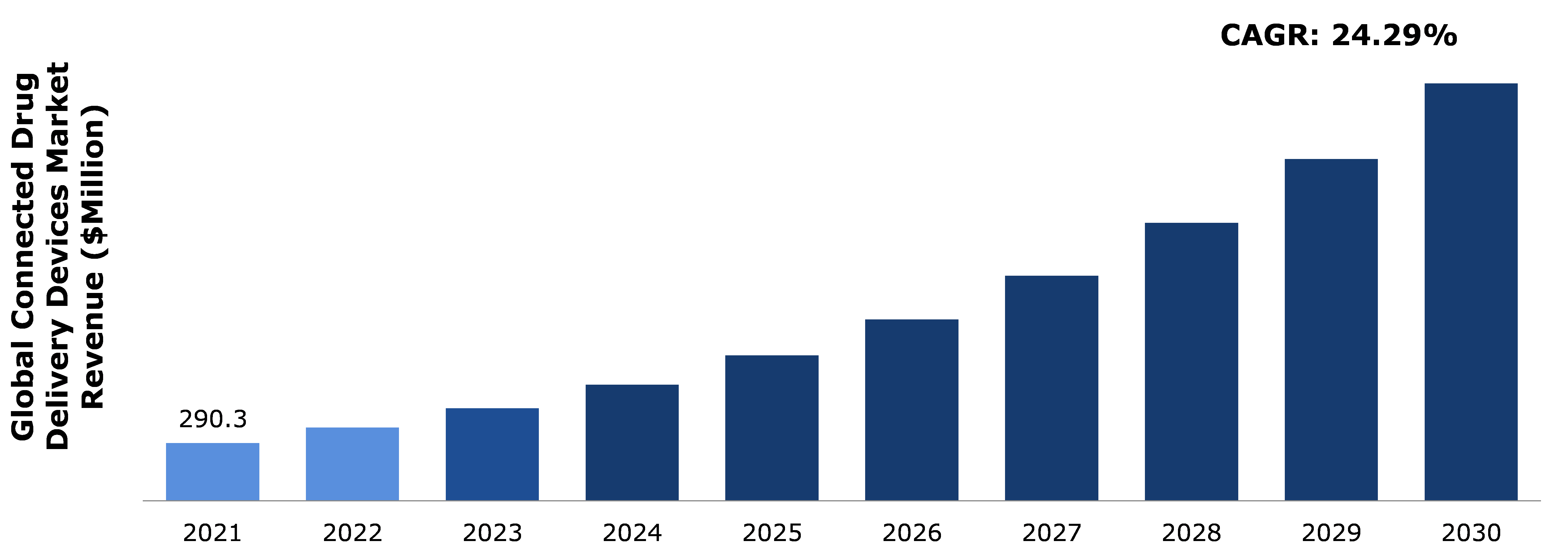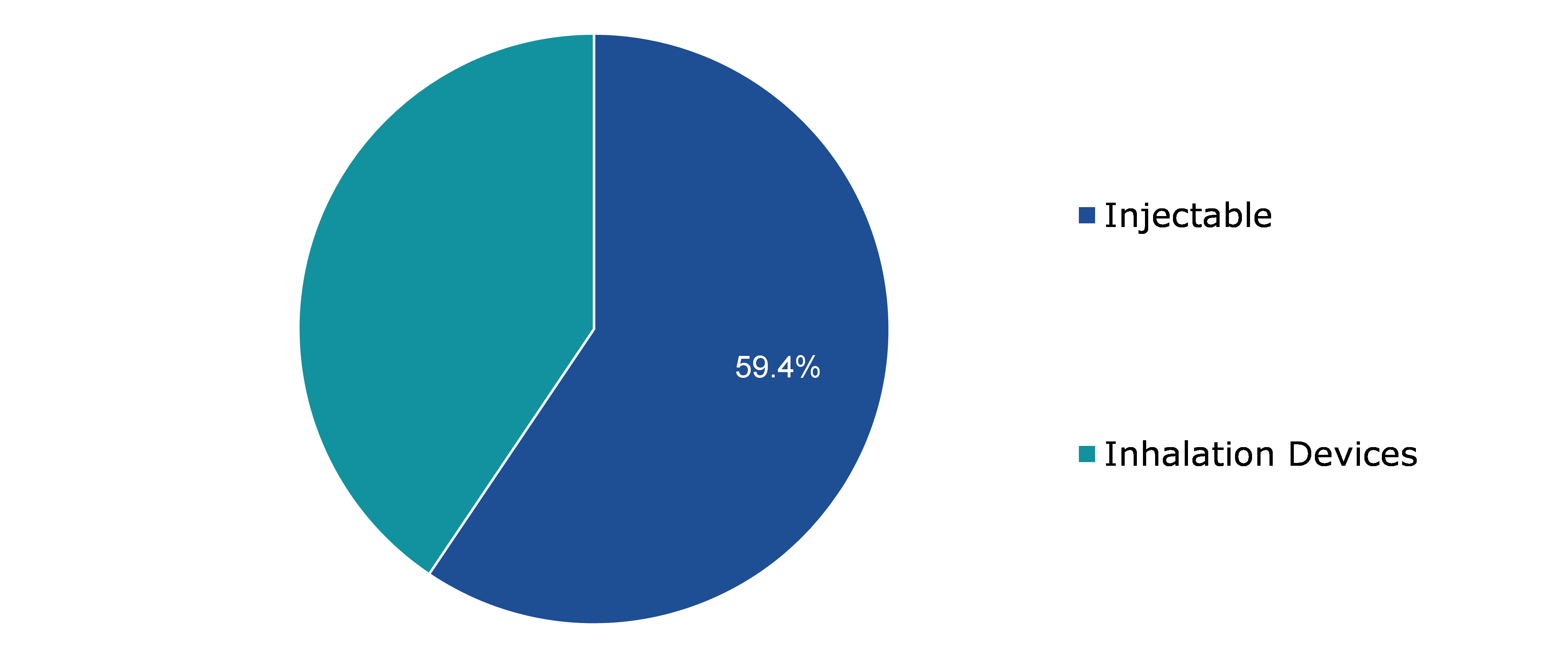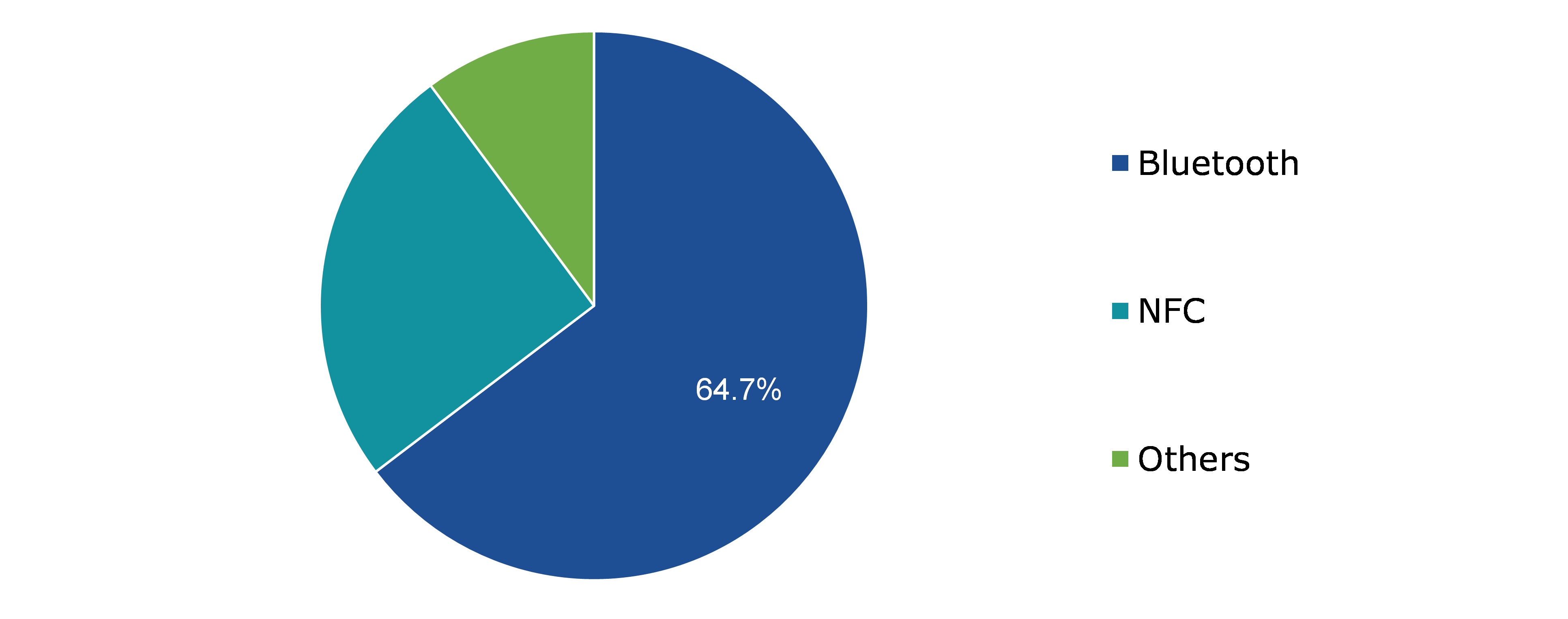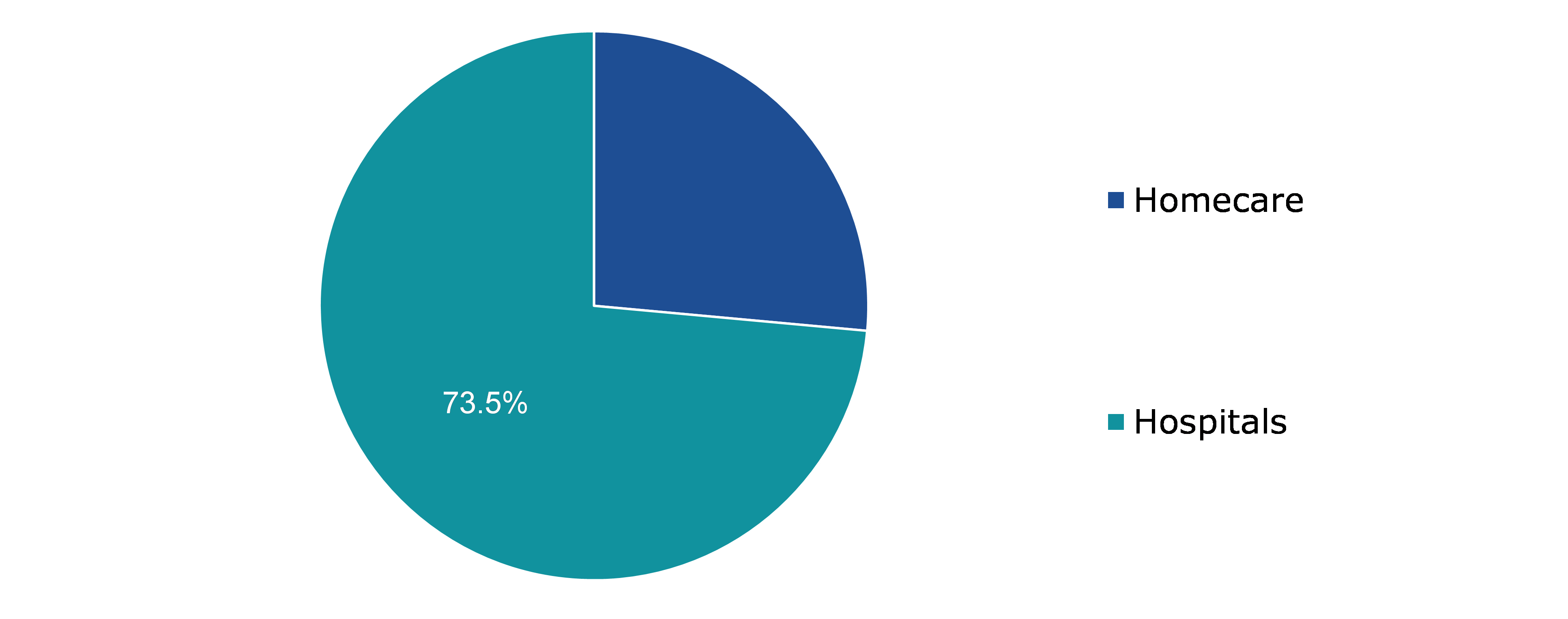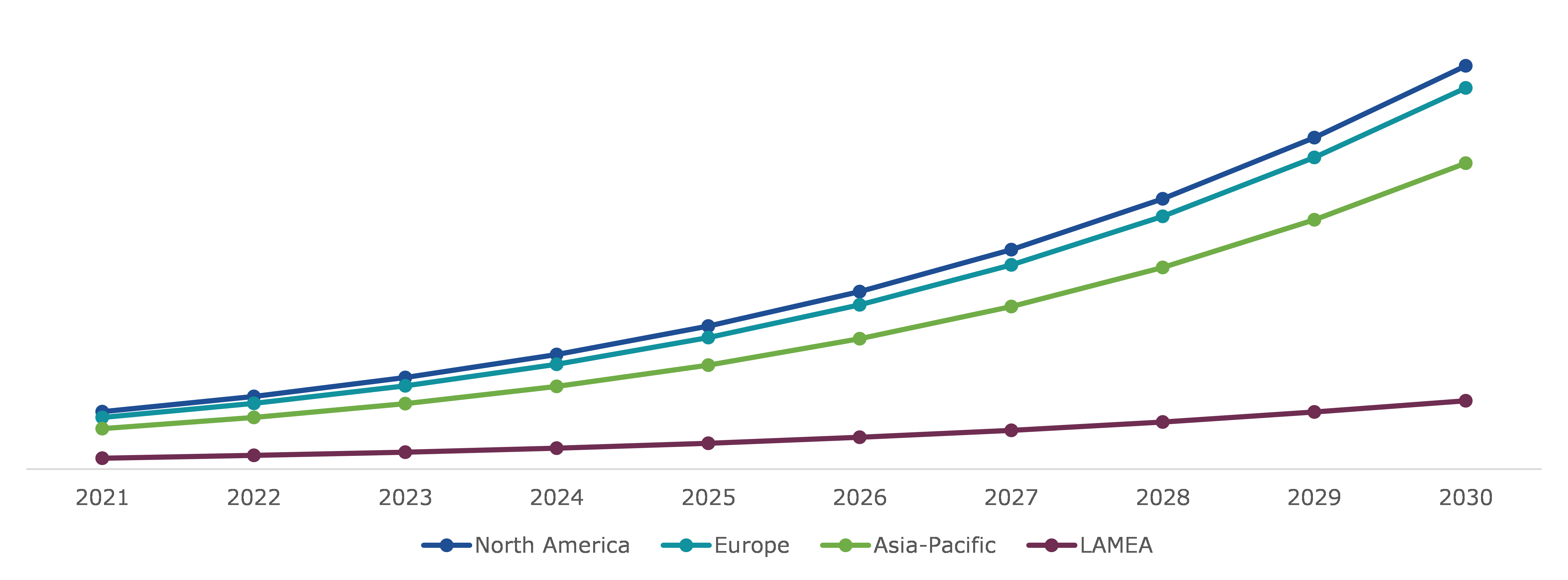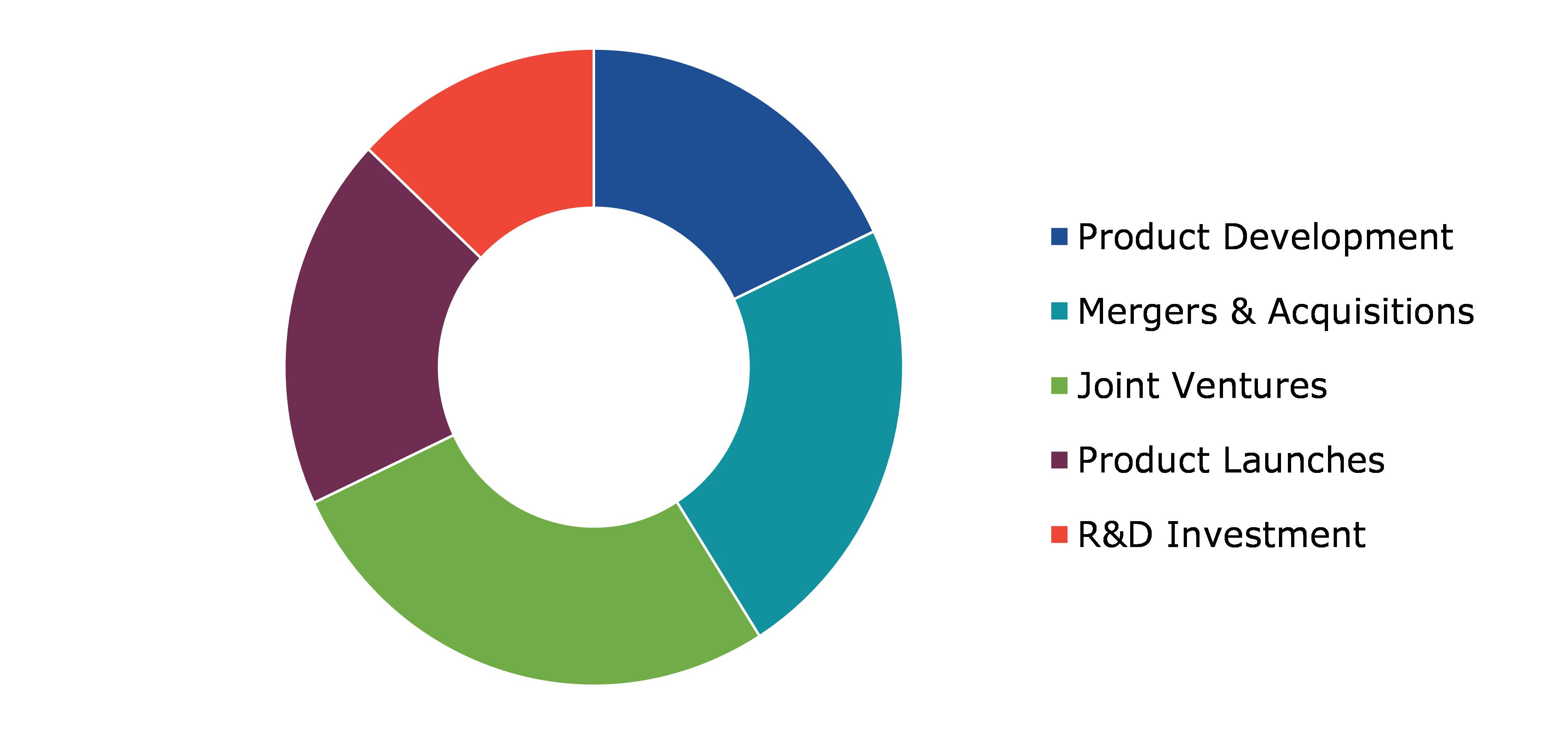Connected Drug Delivery Devices Market Report
RA00348
Connected Drug Delivery Devices Market by Type (Inhalation Devices, Injectable Devices, and Others), Technology (Bluetooth, NFC, and Others), End-user (Homecare Settings and Hospitals), and Regional Analysis (North America, Europe, Asia Pacific, and LAMEA): Global Opportunity Analysis and Industry Forecast, 2022-2030
Global Connected Drug Delivery Devices Market Analysis
The global connected drug delivery devices Market share was $290.3 million in 2021 and is predicted to grow with a CAGR of 24.29%, by generating a revenue of $2,095.2 million by 2030.
Market Synopsis
Connected drug delivery devices market value is gaining significant popularity as they help in addressing patient’s issues associated with disease management protocols, treatments, and medications. Connected drug delivery is one of the emerging solutions equipped with a sensor that facilitates connection and transfer of data to servers/applications via Near Field Communication (NFC), Bluetooth, or cellular networks. One of the major advantage of these connected drug delivery devices is they provide reminders and adherence trackers to patient, linked drug delivery systems reduce the effort needed by patients to stick to the recommended medication regimen. This translates to less expensive prescription waste, including the increasingly popular injectable biologic medicines that insurers would have to pay for. Connected drug delivery systems enable doctors keep track of how effectively their patients are adhering to their prescribed treatments and adjust the patient's care as necessary. For instance, people with chronic diseases such as diabetes and asthma, connected drug delivery device can be helpful for self-medication management. These factors are anticipated to boost the market growth in the upcoming years.
However, some of the disadvantages of connected drug devices include environmental concern for the disposal of electronic waste. The insufficient knowledge related to technology used in connected drug delivery devices and use of these devices is projected to restrict the market growth.
The use of connected drug delivery devices is anticipated to gain significant market share. This is due to connected drug delivery devices can be connected to smartphones with Bluetooth and Near Field Communication (NFC) which enable the dosing reminders and dosage monitoring. Chronic diseases such as diabetes and asthma are becoming more common and most of the patients with asthma and diabetes struggle to manage their medications and follow their doctor’s directions. Self-management of medications with connected medicine delivery systems is possible as these drug delivery devices can send notifications and reminders related to medications.
According to regional analysis, the North America connected drug delivery devices has dominated the market and accounted for $73.2 million in 2021 and is predicted to grow with a CAGR of 24.93% in the projected timeframe. This is due to increase in the prevalence of asthma and diabetes patients in this region due to unhealthy lifestyle and increasing pollution. Patients who are facing challenges in managing medications timings and adherence to prescriptions are adopting connected drug delivery devices. These factors are expected to drive the market growth in analysis period.
Connected Drug Delivery Devices Overview
Connected drug delivery devices keep track of patient drug usage as well as its use and also maintain the health records. These tools make it possible to administer and track the medications in home healthcare settings without involvement of healthcare professionals and also avoid any medication delivery errors. The management of medications, adherence to prescriptions, visits to healthcare providers, and maintaining a healthy diet was difficult for patients with diabetes and asthma as a result drug delivery systems with connectivity may be helpful for self-management of such patients. The rise in chronic diseases such as diabetes and asthma illustrates how important networked medicine delivery systems may become in the near future.
Impact Analysis of COVID-19 on the Global Connected Drug Delivery Devices Market
The COVID-19 pandemic has adversely affected the world and increased the demand for the healthcare facilities. This accelerated the trend toward overhauling the healthcare system for better support and the rapid advancement of technology. While most global markets collapsed in 2020, the connected medicine delivery devices industry demonstrated strong development under challenging circumstances during which the majority of the countries were under lockdown. Due to the unexpected increase in demand for drug delivery systems for home care use as a result of the lockdown limitations, led to the increased demand for the connected drug delivery devices. As a result, use of connected medicine delivery device has been raised over the previous few year. However, in June 2020, Propeller Health, the leading digital health company, entered into partnership with Novartis. Through this partnership Propeller’s digital health platform has co-packed ‘Enerzair Breezhaler’ for the effective treatment of asthmatic patients. Propeller Health has attached sensors to enerzair breezhaler inhaler which delivers data to the Propeller’s mobile application on the patient’s smartphone. These initiatives and technological advancements may result in the establishment of profitable business opportunities for the global connected drug delivery devices market growth. By implementing such effective strategies, companies all over the world are gaining trust of the public and trying to prepare more opportunities for the global connected drug delivery devices market in the forecast period.
Increasing Prevalence of Chronic Diseases is Expected to Drive the Connected Drug Delivery Devices Market Growth
Increasing prevalence of chronic diseases such as asthma, diabetes, and COPD amongst the people across the globe is expected to drive the connected drug delivery devices market growth. For instance, in January 2022, report on diabetes prevalence estimates for 2021 published by National library of medicine, National center for biotechnology information has estimated the prevalence of diabetes in 20-79 years old in 2021 to be 10.5% and may rise up-to 12.2% by 2045. The prevalence of diabetes is estimated to be similar in men & women and was highest amongst those aged 75- 79 years. Additionally, demand for connected drug delivery devices which have higher advantages has also been gradually replacing manual drug administration devices. These factors are expected to drive revenue growth of connected drug delivery devices market.
To know more about global connected drug delivery devices market drivers, get in touch with our analysts here.
Concerns about Patient/ User Data Security could Restrain the Connected Drug Delivery Devices Market Growth
Concerns regarding patient data security is predicted to restrain the connected drug delivery device industry from growing. The loss of important information such as insurance IDs and medical records that may contain bank information, medical details, and location could severely affect the data privacy of patient as a result the reputation of the manufacturer of connected drug delivery devices can suffer. Hospitals, patients, and outside service providers may all be at considerable danger due to the threat of cyber security. Such severe and important risks related to connected drug delivery device solutions could reduce market revenue during the anticipated period. This factors are anticipated to hamper the connected drug delivery devices market growth.
Increasing Focus on Cutting-edge Technologies in Connected Drug Delivery Devices Expected to Lead to Excellent Growth Opportunities
The connected drug delivery devices market is rapidly expanding due to the use of cutting-edge technologies. Major players in the market are using the most recent technology in the development of extremely efficient connected drug delivery devices. Several new as well as established organizations are investing and focusing more on connected drug delivery devices due to the advancements in technology. For instance, in May 2022, Teva Pharmaceutical Industries Ltd., the global leader in generic medicine, launched their new development Pro-air Digihaler (albuterol sulfate) to address the asthma treatment challenges. These factors are anticipated to create attractive market prospects for the development of connected drug delivery devices.
To know more about global connected drug delivery devices market opportunities, get in touch with our analysts here.
Global Connected Drug Delivery Devices Market Share, by Type
Based on type, the connected drug delivery device market has been divided into inhalation devices, injectable devices, and others. Among these, the injectable devices sub-segment accounted for the highest market share in 2021 whereas the inhalation devices sub-segment is estimated to show the fastest growth during the forecast period.
Global Connected Drug Delivery Devices Market Size, by Type, 2021
Source: Research Dive Analysis
The injectable devices sub-type is anticipated to have a dominant market share and generate a revenue of $1,203.1 million by 2030, growing from $172.5 million in 202. Due to the efficiency of medication delivery to the target, injectable drug delivery is recognized as the most effective form of administration. Additionally, during the anticipated years, the global market for linked injectable devices is expected to rise more quickly due to the rapidly expanding use of electronic technology in medical equipment.
The inhalation devices sub-type is anticipated to show the fastest growth and generate a revenue of $892.1 million by 2030, increasing from $117.8 million in 2021. This is due to the increasing incidence and prevalence of respiratory chronic diseases such as asthma, COPD, ARDS and others. The relief for such chronic respiratory diseases and acute exacerbations is provided by these inhalation devices. COVID-19 has increased this number further as the long term effects of COVID-19 includes the permanent damage to lungs.
Global Connected Drug Delivery Devices Market Trends, by Technology
Based on technology, the connected drug delivery devices market has been divided into Bluetooth, NFC, and others. Among these, the Bluetooth sub-segment accounted for highest revenue share in 2021.
Global Connected Drug Delivery Devices Market Forecast, by Technology, 2021
Source: Research Dive Analysis
The Bluetooth sub-segment is anticipated to have a dominant market share and generate a revenue of $1,375.6 million by 2030, growing from $187.7 million in 2021. Due of the extensive availability of inexpensive connection access to smartphones, Bluetooth-based drug delivery devices are among the top choices in the delivery of medications. The businesses engaged in international trade are working to strengthen their positions in the world market by creating unique goods and technology such as Bluetooth technology based inhalers, bio-sensors, and others. These factors are anticipated to boost growth of the Bluetooth sub-segment during the analysis timeframe.
The NFC sub-segment is anticipated to show the fastest growth and shall generate a revenue of $548.3 million by 2030, increasing from $73.1 million in 2021. Drug distribution using Near Field Communication (NFC) technology significantly improves patient outcomes. Long battery life, faster data transfer, and outstanding precision are the characteristics expected to drive growth for NFC devices during the analysis timeframe, which will ultimately encourage the sub-segment growth.
Global Connected Drug Delivery Devices Market Value, by End-user
Based on end-user, the connected drug delivery devices market has been divided into homecare settings and hospitals. Among these, the hospitals sub-segment accounted for highest revenue share in 2021.
Global Connected Drug Delivery Devices Market Growth, by End-user, 2021
Source: Research Dive Analysis
The hospitals sub-segment is anticipated to have a dominant market share and generate a revenue of $1,517.9 million by 2030, growing from $213.5 million in 2021. The price of healthcare has increased significantly during the recent years due to adoption of new technologies. Hospitals are becoming digitalized rapidly as a result of the adoption of electronic and networking technologies. The hospitals sub-segment is expected to grow significantly in revenue over the forecast period due to increasing adoption of connected drug delivery solutions in hospitals, smartphones to assist healthcare professionals, and integrated diagnostic technology for improved disease detection.
The homecare settings sub-segment is anticipated to show the fastest growth and shall generate a revenue of $577.3 million by 2030, increasing from $76.8 million in 2021. The spread of technology in homecare settings for treatment and tracking of medications of patients is increasing with the support of Cloud computing and Artificial Intelligence. It is anticipated that a rising elderly population and an increase in the frequency of chronic respiratory disorders may increase growth opportunities for the sub-segment during the forecast period.
Global Connected Drug Delivery Devices Market Growth, by Region
The connected drug delivery devices market was investigated across North America, Europe, Asia-Pacific, and LAMEA.
Global Connected Drug Delivery Devices Market Size & Forecast, by Region, 2021-2030 (USD Million)
Source: Research Dive Analysis
The Market for Connected Drug Delivery Devices in North-America to be the Most Dominant
The North America connected drug delivery devices market accounted $103.9 million in 2021 and is projected to grow with a CAGR of 23.89%. Some of the key drivers that are anticipated to boost demand for connected drug delivery devices in the North America market are rising prevalence of chronic illnesses, technological advancements, and cutting-edge linked drug delivery solutions. The rising use of integrated devices and quick adoption of wireless and Wi-Fi-enabled the faster adoption of connected drug delivery systems amongst the people in this region. These factors are expected to increase the connected drug delivery devices market growth in analysis period.
The Market for Connected Drug Delivery Devices in Asia-Pacific to be the Fastest Growing
The Asia-Pacific connected drug delivery devices market accounted $73.2 million in 2021 and is projected to grow with a CAGR of 24.93%. The region is expected to maintain its top position during the forecast period due to its high per capita healthcare spending, rapid adoption of new technology and devices, and increasing awareness of regarding connected drug delivery devices.
Competitive Scenario in the Global Connected Drug Delivery Devices Market
Product development, technological advancement and joint ventures are the common strategies followed by major market players of conned drug delivery devices market. For instance, in June 2021, Adherium Limited a multinational respiratory e-health company submitted their 510(k) application to the U.S. FDA for the market clearance of their first generation Hailie sensor which has physiological measures to monitor asthma and COPD medication use. This new product development is expected to boost the sales of the company in analysis period.
Source: Research Dive Analysis
Some of the leading connected drug delivery devices market players are Propeller Health, BD, Syncro Technology Corp., Adherium, F. Hoffmann-La Roche Ltd, West Pharmaceutical Services, Inc., Ypsomed AG, AptarGroup Inc., Cohero Health, Inc., and Proteus Digital Health.
| Aspect | Particulars |
| Historical Market Estimations | 2020-2021 |
| Base Year for Market Estimation | 2021 |
| Forecast Timeline for Market Projection | 2021-2030 |
| Geographical Scope | North America, Europe, Asia-Pacific, and LAMEA |
| Segmentation by Type |
|
| Segmentation by Technology |
|
| Segmentation by End-user |
|
| Key Companies Profiled |
|
Q1. What is the size of the global connected drug delivery devices market?
A. The size of the global connected drug delivery devices market was over $290.3 million in 2021 and is projected to reach $2,095.2 million by 2030.
Q2. Which are the major companies in the connected drug delivery devices market?
A. Propeller Health, AptarGroup Inc., and Cohero Health, Inc. are some of the key players in the global connected drug delivery devices market.
Q3. Which region, among others, possesses greater investment opportunities in the near future?
A. The Asia-Pacific region possesses great investment opportunities for investors to witness the most promising growth in the future.
Q4. What will be the growth rate of the Asia-Pacific connected drug delivery devices market?
A. Asia-Pacific connected drug delivery devices market is anticipated to grow at 24.93% CAGR during the forecast period.
Q5. What are the strategies opted by the leading players in this market?
A. Product development, joint venture, and technological advancements are the key strategies opted by the operating companies in this market.
Q6. Which companies are investing more on R&D practices?
A. Adherium and BD are the companies investing more on R&D activities for developing new products and technologies.
1.Research Methodology
1.1.Desk Research
1.2.Real time insights and validation
1.3.Forecast model
1.4.Assumptions and forecast parameters
1.5.Market size estimation
1.5.1.Top-down approach
1.5.2.Bottom-up approach
2.Report Scope
2.1.Market definition
2.2.Key objectives of the study
2.3.Report overview
2.4.Market segmentation
2.5.Overview of the impact of COVID-19 on Global connected drug delivery devices market
3.Executive Summary
4.Market Overview
4.1.Introduction
4.2.Growth impact forces
4.2.1.Drivers
4.2.2.Restraints
4.2.3.Opportunities
4.3.Market value chain analysis
4.3.1.List of raw material suppliers
4.3.2.List of manufacturers
4.3.3.List of distributors
4.4.Innovation & sustainability matrices
4.4.1.Technology matrix
4.4.2.Regulatory matrix
4.5.Porter’s five forces analysis
4.5.1.Bargaining power of suppliers
4.5.2.Bargaining power of consumers
4.5.3.Threat of substitutes
4.5.4.Threat of new entrants
4.5.5.Competitive rivalry intensity
4.6.PESTLE analysis
4.6.1.Political
4.6.2.Economical
4.6.3.Social
4.6.4.Technological
4.6.5.Environmental
4.7.Impact of COVID-19 on connected drug delivery devices market
4.7.1.Pre-covid market scenario
4.7.2.Post-covid market scenario
5.Connected Drug Delivery Devices Market Analysis, by Type
5.1.Overview
5.2.Inhalation Devices
5.2.1.Definition, key trends, growth factors, and opportunities
5.2.2.Market size analysis, by region,2021-2030
5.2.3.Market share analysis, by country,2021-2030
5.3.Injectable Devices
5.3.1.Definition, key trends, growth factors, and opportunities
5.3.2.Market size analysis, by region,2021-2030
5.3.3.Market share analysis, by country,2021-2030
5.4.Others
5.4.1.Definition, key trends, growth factors, and opportunities
5.4.2.Market size analysis, by region,2021-2030
5.4.3.Market share analysis, by country,2021-2030
5.5.Research Dive Exclusive Insights
5.5.1.Market attractiveness
5.5.2.Competition heatmap
6.Connected Drug Delivery Devices Market Analysis, by Technology
6.1.Overview
6.2.Bluetooth
6.2.1.Definition, key trends, growth factors, and opportunities
6.2.2.Market size analysis, by region,2021-2030
6.2.3.Market share analysis, by country,2021-2030
6.3.NFC
6.3.1.Definition, key trends, growth factors, and opportunities
6.3.2.Market size analysis, by region,2021-2030
6.3.3.Market share analysis, by country,2021-2030
6.4.Others
6.4.1.Definition, key trends, growth factors, and opportunities
6.4.2.Market size analysis, by region,2021-2030
6.4.3.Market share analysis, by country,2021-2030
6.5.Research Dive Exclusive Insights
6.5.1.Market attractiveness
6.5.2.Competition heatmap
7.Connected Drug Delivery Devices Market Analysis, by End-user
7.1.Homecare Settings
7.1.1.Definition, key trends, growth factors, and opportunities
7.1.2.Market size analysis, by region,2021-2030
7.1.3.Market share analysis, by country,2021-2030
7.2.Hospitals
7.2.1.Definition, key trends, growth factors, and opportunities
7.2.2.Market size analysis, by region,2021-2030
7.2.3.Market share analysis, by country,2021-2030
7.3.Research Dive Exclusive Insights
7.3.1.Market attractiveness
7.3.2.Competition heatmap
8.Connected Drug Delivery Devices Market, by Region
8.1.North America
8.1.1.U.S.
8.1.1.1.Market size analysis, by Type,2021-2030
8.1.1.2.Market size analysis, by Technology,2021-2030
8.1.1.3.Market size analysis, by End-user,2021-2030
8.1.2.Canada
8.1.2.1.Market size analysis, by Type,2021-2030
8.1.2.2.Market size analysis, by Technology,2021-2030
8.1.2.3.Market size analysis, by End-user,2021-2030
8.1.3.Mexico
8.1.3.1.Market size analysis, by Type,2021-2030
8.1.3.2.Market size analysis, by Technology,2021-2030
8.1.3.3.Market size analysis, by End-user,2021-2030
8.1.4.Research Dive Exclusive Insights
8.1.4.1.Market attractiveness
8.1.4.2.Competition heatmap
8.2.Europe
8.2.1.Germany
8.2.1.1.Market size analysis, by Type,2021-2030
8.2.1.2.Market size analysis, by Technology,2021-2030
8.2.1.3.Market size analysis, by End-user,2021-2030
8.2.2.UK
8.2.2.1.Market size analysis, by Type,2021-2030
8.2.2.2.Market size analysis, by Technology,2021-2030
8.2.2.3.Market size analysis, by End-user,2021-2030
8.2.3.France
8.2.3.1.Market size analysis, by Type,2021-2030
8.2.3.2.Market size analysis, by Technology,2021-2030
8.2.3.3.Market size analysis, by End-user,2021-2030
8.2.4.Spain
8.2.4.1.Market size analysis, by Type,2021-2030
8.2.4.2.Market size analysis, by Technology,2021-2030
8.2.4.3.Market size analysis, by End-user,2021-2030
8.2.5.Italy
8.2.5.1.Market size analysis, by Type,2021-2030
8.2.5.2.Market size analysis, by Technology,2021-2030
8.2.5.3.Market size analysis, by End-user,2021-2030
8.2.6.Rest of Europe
8.2.6.1.Market size analysis, by Type,2021-2030
8.2.6.2.Market size analysis, by Technology,2021-2030
8.2.6.3.Market size analysis, by End-user,2021-2030
8.2.7.Research Dive Exclusive Insights
8.2.7.1.Market attractiveness
8.2.7.2.Competition heatmap
8.3.Asia-Pacific
8.3.1.China
8.3.1.1.Market size analysis, by Type,2021-2030
8.3.1.2.Market size analysis, by Technology,2021-2030
8.3.1.3.Market size analysis, by End-user,2021-2030
8.3.2.Japan
8.3.2.1.Market size analysis, by Type,2021-2030
8.3.2.2.Market size analysis, by Technology,2021-2030
8.3.2.3.Market size analysis, by End-user,2021-2030
8.3.3.India
8.3.3.1.Market size analysis, by Type,2021-2030
8.3.3.2.Market size analysis, by Technology,2021-2030
8.3.3.3.Market size analysis, by End-user,2021-2030
8.3.4.Australia
8.3.4.1.Market size analysis, by Type,2021-2030
8.3.4.2.Market size analysis, by Technology,2021-2030
8.3.4.3.Market size analysis, by End-user,2021-2030
8.3.5.South Korea
8.3.5.1.Market size analysis, by Type,2021-2030
8.3.5.2.Market size analysis, by Technology,2021-2030
8.3.5.3.Market size analysis, by End-user,2021-2030
8.3.6.Rest of Asia-Pacific
8.3.6.1.Market size analysis, by Type,2021-2030
8.3.6.2.Market size analysis, by Technology,2021-2030
8.3.6.3.Market size analysis, by End-user,2021-2030
8.3.7.Research Dive Exclusive Insights
8.3.7.1.Market attractiveness
8.3.7.2.Competition heatmap
8.4.LAMEA
8.4.1.Brazil
8.4.1.1.Market size analysis, by Type,2021-2030
8.4.1.2.Market size analysis, by Technology,2021-2030
8.4.1.3.Market size analysis, by End-user,2021-2030
8.4.2.Saudi Arabia
8.4.2.1.Market size analysis, by Type,2021-2030
8.4.2.2.Market size analysis, by Technology,2021-2030
8.4.2.3.Market size analysis, by End-user,2021-2030
8.4.3.UAE
8.4.3.1.Market size analysis, by Type,2021-2030
8.4.3.2.Market size analysis, by Technology,2021-2030
8.4.3.3.Market size analysis, by End-user,2021-2030
8.4.4.South Africa
8.4.4.1.Market size analysis, by Type,2021-2030
8.4.4.2.Market size analysis, by Technology,2021-2030
8.4.4.3.Market size analysis, by End-user,2021-2030
8.4.5.Rest of LAMEA
8.4.5.1.Market size analysis, by Type,2021-2030
8.4.5.2.Market size analysis, by Technology,2021-2030
8.4.5.3.Market size analysis, by End-user,2021-2030
8.4.6.Research Dive Exclusive Insights
8.4.6.1.Market attractiveness
8.4.6.2.Competition heatmap
9.Competitive Landscape
9.1.Top winning strategies, 2021
9.1.1.By strategy
9.1.2.By year
9.2.Strategic overview
9.3.Market share analysis, 2021
10.Company Profiles
10.1.Propeller Health
10.1.1.Overview
10.1.2.Business segments
10.1.3.Product portfolio
10.1.4.Financial performance
10.1.5.Recent developments
10.1.6.SWOT analysis
10.2.BD
10.2.1.Overview
10.2.2.Business segments
10.2.3.Product portfolio
10.2.4.Financial performance
10.2.5.Recent developments
10.2.6.SWOT analysis
10.3.Syncro Technology Corp.
10.3.1.Overview
10.3.2.Business segments
10.3.3.Product portfolio
10.3.4.Financial performance
10.3.5.Recent developments
10.3.6.SWOT analysis
10.4.Adherium
10.4.1.Overview
10.4.2.Business segments
10.4.3.Product portfolio
10.4.4.Financial performance
10.4.5.Recent developments
10.4.6.SWOT analysis
10.5.F. Hoffmann-La Roche Ltd
10.5.1.Overview
10.5.2.Business segments
10.5.3.Product portfolio
10.5.4.Financial performance
10.5.5.Recent developments
10.5.6.SWOT analysis
10.6.West Pharmaceutical Services, Inc.
10.6.1.Overview
10.6.2.Business segments
10.6.3.Product portfolio
10.6.4.Financial performance
10.6.5.Recent developments
10.6.6.SWOT analysis
10.7.Ypsomed AG
10.7.1.Overview
10.7.2.Business segments
10.7.3.Product portfolio
10.7.4.Financial performance
10.7.5.Recent developments
10.7.6.SWOT analysis
10.8.AptarGroup Inc.
10.8.1.Overview
10.8.2.Business segments
10.8.3.Product portfolio
10.8.4.Financial performance
10.8.5.Recent developments
10.8.6.SWOT analysis
10.9.Cohero Health, Inc.
10.9.1.Overview
10.9.2.Business segments
10.9.3.Product portfolio
10.9.4.Financial performance
10.9.5.Recent developments
10.9.6.SWOT analysis
10.10.Proteus Digital Health Inc.
10.10.1.Overview
10.10.2.Business segments
10.10.3.Product portfolio
10.10.4.Financial performance
10.10.5.Recent developments
10.10.6.SWOT analysis
11.Appendix
11.1.Parent & peer market analysis
11.2.Premium insights from industry experts
11.3.Related reports
The outbreak of the COVID-19 pandemic triggered an urgent need to lessen the strain on healthcare sector and its resources. As a result, the adoption of teleconsultations and patient self-administration greatly surged for relieving some of this pressure. In fact, remote healthcare services became among the top three benefits of digitalization in healthcare amidst the pandemic. This propelled advancements in digital competences in the area of drug delivery. Connected drug delivery devices became increasingly popular, as they became a perfect aid for patients with chronic diseases during the pandemic situation.
Connected delivery solutions offer great value to the healthcare industry as well as patients, by providing enhanced medication adherence and outcome optimization. Supplying drugs by means of connected devices, such as smart inhalers, auto-injectors, and closed-loop solutions, has been accepted as a promising method of enhancing patient adherence and plummeting errors in dosing, mostly in the home settings.
Newest Insights in the Connected Drug Delivery Devices Market
As per a report by Research Dive, the global connected drug delivery devices market s expected to grow with a striking CAGR of 24.29% in the 2022–2030 timeframe. The Asia-Pacific connected drug delivery devices market is expected to perceive rapid growth with a CAGR of 24.93% in the years to come. This is because, the region has an enormous demand for connected drug delivery devices owing to the growing cases of chronic diseases, high per capita healthcare expenditure, speedy acceptance of novel technologies and devices, and growing awareness about connected drug delivery devices in the region.
How are Market Players Responding to the Rising Demand for Connected drug delivery devices?
Growing occurrence of chronic ailments such as diabetes, asthma, and COPD among the people worldwide is driving the demand for connected drug delivery devices. Market players are greatly investing in innovative researches and developments to cater the rising demand for connected drug delivery devices. Some of the foremost players of the connected drug delivery devices market are Cohero Health, Inc., Propeller Health, Syncro Technology Corp., BD, Proteus Digital Health., Adherium, F. Hoffmann-La Roche Ltd, West Pharmaceutical Services, Inc., Ypsomed AG, AptarGroup Inc., and others. These players are focused on planning and devising tactics such as mergers and acquisitions, collaborations, novel advances, and partnerships to reach a notable position in the global market.
For instance,
- In January 2022, Innovation Zed, a developer of connected health solutions that support drug adherence and condition management, announced to launch InsulCheck® DOSE, a connected add-on device that converts conventional pen injectors into smart devices to aid the monitoring of disease management regimen.
- In February 2022, Aptar Pharma, a worldwide frontrunner in drug delivery services, devices, and active material science solutions, launched HeroTracker® Sense, an innovative digital respiratory healthcare solution that converts a usual metered dose inhaler (pMDI) into a smart connected healthcare solution.
- In May 2022, Jabil Healthcare, a major global supplier of healthcare manufacturing solutions, launched a platform called, Qfinity™ autoinjector. This platform is a reusable & integrated solution for subcutaneous (SC) drug self-administration, at an affordable price as compared to its alternatives available in the market.
COVID-19 Impact on the Global Connected Drug Delivery Devices Market
The unexpected rise of the coronavirus pandemic in 2020 has optimistically impacted the global connected drug delivery devices market. During the pandemic period, the unpredicted surge in the demand for drug delivery solutions for self-administration or home care use due to the lockdown restrictions propelled the demand for connected drug delivery devices. The connected drug delivery devices market has witnessed robust growth under the disastrous situations during the pandemic, and the market is projected to observe massive growth in the forthcoming years as well.
Personalize this research
- Triangulate with your own data
- Request your format and definition
- Get a deeper dive on a specific application, geography, customer or competitor
- + 1-888-961-4454 Toll - Free
- support@researchdive.com

